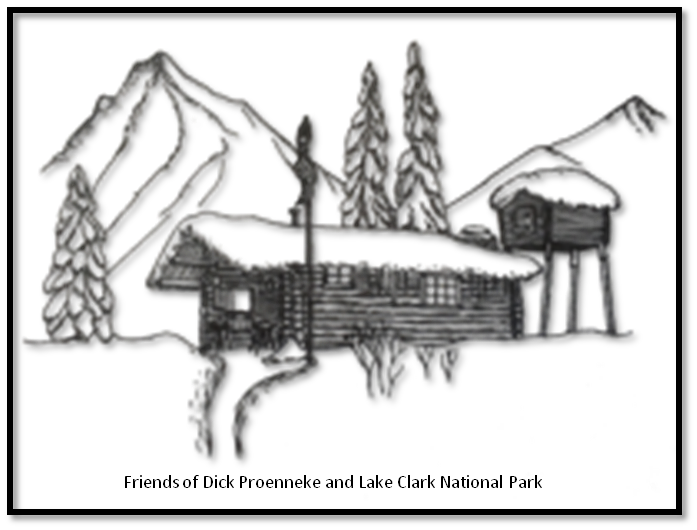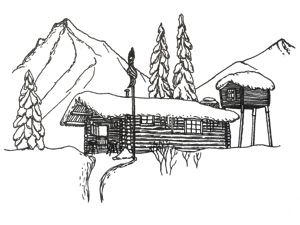Friends of Dick Proenneke’s First Funded Project.
The restoration of Dick Proenneke’s cabin roof became urgent when, in 2016, a layer of mold was discovered throughout the interior of the cabin. A roof restoration project had been planned for other needed cabin maintenance but now it was of the utmost importance that the work be done immediately.
Therefore, in 2017, Friends of Dick Proenneke and Lake Clark National Park supported this roof restoration project, the first project in partnership with the National Park Service (NPS). The support of the Friends Group provided increased flexibility to the park in how the project was accomplished. This flexibility allowed Monroe Robinson, log restoration specialist who has done all the work to maintain the Proenneke cabin for the past 17 years since Dick left, and Al Williams, a retired career Historic Preservation Specialist to work together on the roof. This type of flexibility is highly valued and appreciated by the National Park staff as they seek to ensure the highest quality work possible is done at the cabin. The park sees this as one of the most valuable benefits of support from the Friends Group. The successful restoration of the roof on Dick Proenneke’s cabin is a great example of how the Friends Group hopes to support the preservation and interpretation of this site in the future. For all of those who gave donations toward this project, the Friends Group is very thankful.
An entire year of planning went into the development of the project. The park’s historic architect, facilities manager, cultural resource program manager worked with Monroe and Al to plan and develop the project in keeping with the Secretary of Interior’s Standards for Historic Preservation and in consultation with the State of Alaska’s Historic Preservation Officer.
Below is the story of the work on the cabin as supplies and staff arrived at Upper Twin Lake in the heart of the wilderness that was Dick Proenneke’s home for thirty years:
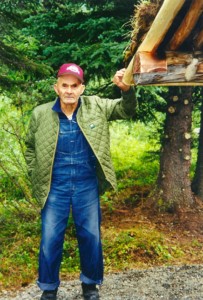
Dick Proenneke’s last visit to the cabin in 2000. Notice the caps on the end logs.
To more clearly understand the 2017 restoration, a history of what has been done on the cabin up to that time would be helpful. In 2000, the year after Dick left, the National Park Service asked Monroe Robinson to consult on what steps were needed to restore Dick Proenneke’s cabin, woodshed and cache. Monroe found the outer pole around the roof’s perimeter of all three structures was badly rotted. Also, the exposed ends of the five major roof logs (the ridge log, two purlins and eve log on each side of the cabin and woodshed) were all rotting and rot would move deeper into those logs, as well, if not stopped. Dick’s original roofing had held up well for the thirty-one years he lived there but now, in 2000, was the time to contain the rot otherwise a major loss of Dick’s craftsmanship would result.
Monroe dealt with the perimeter logs first. He observed that Dick used roofing nails around the perimeter of his roof to hold the tarpaper and visqueen layers prior to installing sod on his roof but the constantly wet sod had caused the two exposed rafter poles on the gable ends and the two half log fascia poles to rot. To keep the extensive rot within each of these small logs around the perimeter of each of Dick’s structures from spreading further into the ends of the rafter poles, Monroe felt it necessary to replace the rotted half log fascia on both sides of Dick’s cabin and the gable end rafter poles, taking great care to keep the new pieces the exact measurements of Dick’s. However, he saw that the wet sod would continue to be a problem. In 2003 he fabricated and installed a copper flashing around the perimeter of all three roofs. The flashing extended the drip line of the roof 1/2″ beyond the roof to keep the sod from touching the wood.
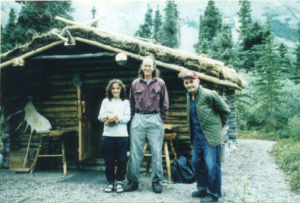
Dick Proenneke with Monroe and Chelsea Robinson in 2000.
Monroe worked on the major roof logs next. He felt that they were not at the level of rot to warrant either replacing nor spliced on new ends since these invasive alternatives would have resulted in a major loss of Dick’s original craftsmanship. To hide the existing rot and stop it from moving further into roof logs, Monroe, in 2000, designed and made end caps to cover the exposed rotted ends of the major roof logs on both the cabin and the woodshed. A cylinder of borax was inserted in a drilled hole in the exposed end of each roof log to add further rot protection.
Monroe did not like installing the highly visible end caps over the ends of Dick’s five roof support logs. Just after their installation Dick arrived for his last visit to his cabin. As he walked up to his cabin, he looked up at the end caps and looking over to Monroe gave a smiling nod.
The changes to Dick Proenneke’s three structures in the 2000 and 2003 will forever protect the craftsmanship of Dick’s original work. This is the most significant early change to the cabin for the sake of protecting the craftsmanship of Dick’s original work. Monroe’s report, photos and video of this early restoration can help future restorations maintain Dick’s structures in their original condition. The 2017 restoration which was also videotaped added further levels of protection to Dick’s craftsmanship.
Collegiality in 2017 between Lake Clark National Park and Preserve staff, Chris Wilcox, Chief of Facility Management, Liza Rupp, Cultural Resources Program Manager and archeologist, and Grant Cosby, Chief Historical Architect and those doing the work made this a textbook restoration project that will endure, maintenance free, for many decades to come.
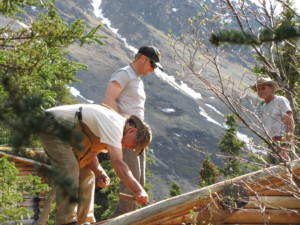
Monroe, Al and Tony at work on Dick’s roof.
All involved in the project felt it was important to alter Dick Proenneke’s original work as little as possible. Any alterations made seemed fitting in order to add longevity to the restoration and these alterations were done keeping as much as possible to Dick’s spirit.
To restore the roof several elements were added that changed Dick’s original work. Each change was carefully considered and discussed during teleconference meetings before the work began. Chris Wilcox suggested adding a layer of plywood. Al Williams suggested a layer of Grace Ice & Water Shield and suggested not to use epoxy on the rotted ends of structural roof logs. Monroe suggested an improved design for the copper roof flashing. In 2000, then Chief Historical Architect, Steve Peterson, suggested using a layer of the EPDM membrane (a type of synthetic rubber) in place of Dick’s use of visqueen above Dick’s tarpaper layer. For the 2017 restoration it was again decided to use the more durable EPDM membrane. Each of these ideas added longevity to the restoration while keeping to Dick’s original craftsmanship.
Monroe Robinson and Al Williams were hired to co-supervise the work along with craftsman, Tony Perelli. The work was done with hand tools as much as possible. All three men felt extremely honored to be doing this work on Dick’s cabin.
The work began the beginning of June with removal of the sod from Dick’s roof and storing it near the shed with help from Danny Dressler, park ranger, and Liza Rupp. This original sod was replaced along with new sod at the end of the project.
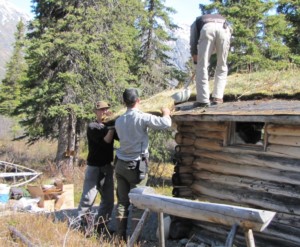
Monroe and Danny carry the sod that Al has cut.
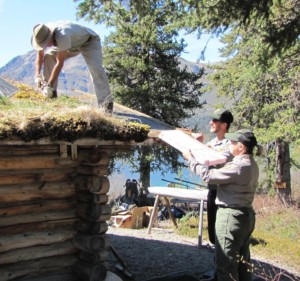
Liza and Danny carry sod.
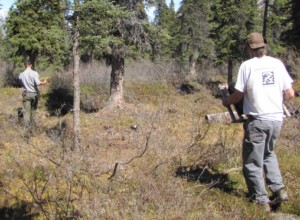
Danny and Monroe store the sod behind cabin.
Once the roof was bare of sod, the EPDM membrane and tarpaper were removed down to the rafter poles. It was 49 years ago when Dick was building his cabin that these rafter poles had last been exposed. Mold cleaner was sprayed on all log surfaces, particularly on what Dick called the ‘squirrel frustraters’ between the rafter poles.
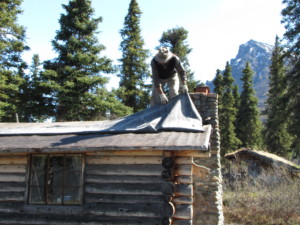
Al pulled the old EPDM membrane off the tarpaper. Monroe replaced Dick’s original visqueen layer with the more durable EPDM membrane during the 2000 roof restoration.
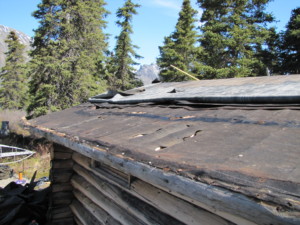
Dick’s original tarpaper exposed. Note the holes in the tarpaper and even one in the EPDM membrane which were made by black bears on the roof.
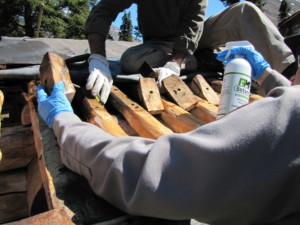
Once the tarpaper was removed Liza applies mold cleaner spray to ‘squirrel frustraters’ and rafter poles.
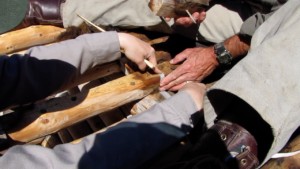
Al and Liza wrapped a closed-cell foam strip between the ‘squirrel frustraters’ and rafter poles. The strip will inhibit the flow of moist air into the cabin which contributed to the mold problem.
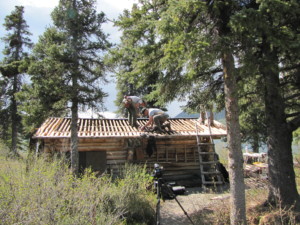
Monroe, Al and Tony scrubbing mold cleaner on exposed rafter poles.
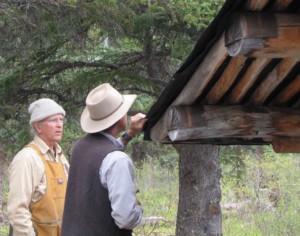
Al and Monroe discuss the copper end caps.
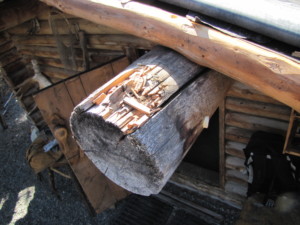
Protected by a copper end cap, the rot in the exposed end of the purlin was unchanged between 2000 and 2017.
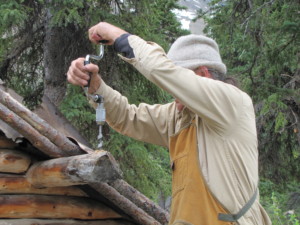
Borax rods are added to the ends of logs.
With intense interest the copper end caps were removed in the 2017 restoration. The level of rot seemed unchanged from 2000. Al pronounced the copper end caps as perfectly doing their intended job and they were reinstalled with rubber washers to hold them slightly away from the log ends for added ventilation.
An additional rod of borax wood preservative was installed in the end of each roof log following the initial rod that Monroe had installed with the previous roof work.
Monroe, Al and Tony could now start to rebuild the roof.
A new layer of 30# tarpaper was rolled over the rafter poles followed by a layer of 1/2″ plywood that was screwed to the rafter poles using a brace and driver bit. To hide the exposed edge of the plywood, it was wrapped with a narrow strip of EPDM membrane. The stiffness of the plywood will protect both the tarpaper and the layers above from damage by a bear or person walking on the sod roof. A layer of Grace, Ice & Water Shield was laid over the plywood. A newly designed 12″ wide strip of copper flashing was installed around the perimeter of the roof followed by a layer of EPDM membrane to cover the entire roof.
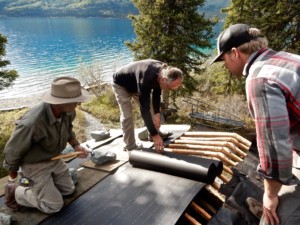
Tarpaper is rolled over the rafter poles.
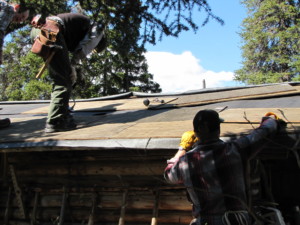
A layer of 1/2″ plywood was screwed down over the tarpaper.
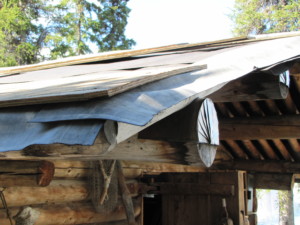
The narrow strip of EPDM membrane before it is wrapped around plywood.
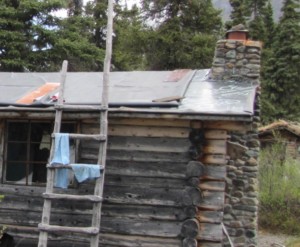
A layer of Grace, Ice and Water Shield was laid over the plywood.
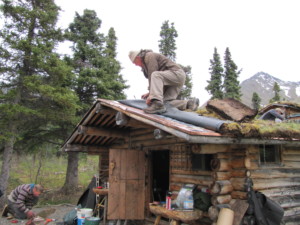
Monroe installing the copper flashing that extends the drip line beyond the roof, thus protecting it from rot.
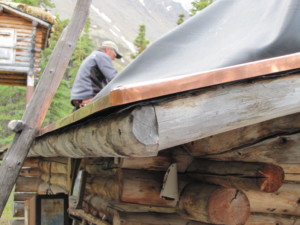
New copper flashing showing how it will hold the wet sod away from the roof while hiding the plywood edge.
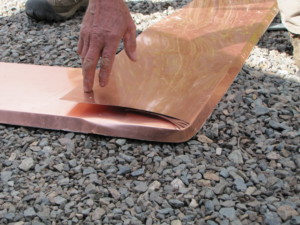
New copper flashing Monroe designed for 2017 restoration.
These photos show the flashing installed in 2003 compared to the new one in 2017.
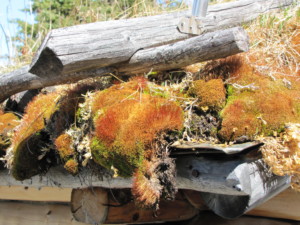
The copper flashing installed in 2003 just under the sod.
In 2003 Monroe lifted the sod around the perimeter of the roof to install a strip of copper flashing that extended the drip line 1/2″ beyond the roof. The extended drip line kept the perimeter poles dryer.
In 2017, seeing how well the flashing had worked over the years, Monroe designed a new flashing that would hide the plywood layer, extend the drip line slightly to keep the pole structure even dryer, and also, make the corners of the flashing safer from a person’s head contacting the corner of the roof.
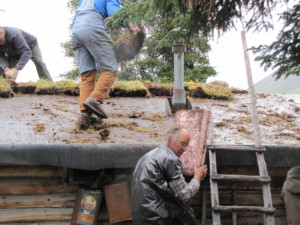
The EPDM membrane has yet to be trimmed along the edge of the roof as sod is put along the ridge of the cabin. Note the copper housing around the stove chimney to keep the sod away from the chimney pipe. Dick fabricated his original flashing around the chimney from a recycled 5 gallon rectangular gas can.
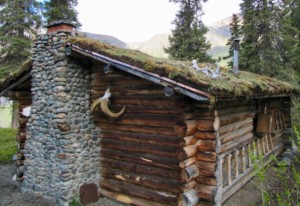
The copper flashing will tarnish within a year to a natural brown patina making it less noticeable to the average visitor.
Warren Hill, maintenance work leader, and Liza Rupp led a Student Conservation Association teen work crew to cut and move new sod for the roof. The sod used in 2017 was harvested from the same carefully selected location as used in the 2000 roof work. Dan and Jennifer Molina (NPS volunteers for 15 years at Lower Twin Lake) transported sod and personnel across the lake.
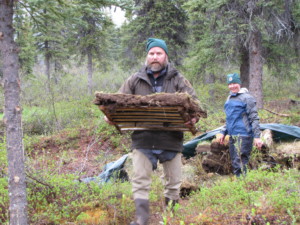
Dan and Jennifer Molina bring new sod and students by boat to the cabin. Then they help move the sod to the cabin roof.
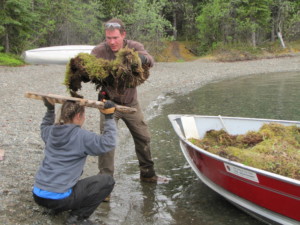
Student Conservation Association interns help put sod on the cabin.
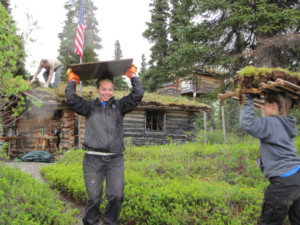
This new sod when added to the old sod completed the roof.
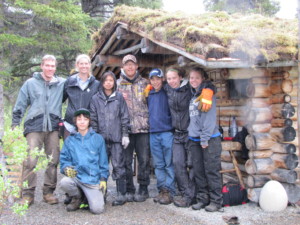
Student Conservation Association interns. Thank you!
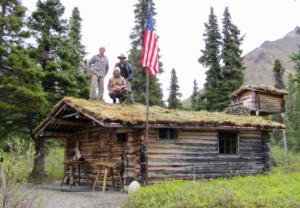
The sod now covered Dick’s new roof. Constructing the cabin’s pole structure to put on the sod was next. Al needed to leave for another NPS project.
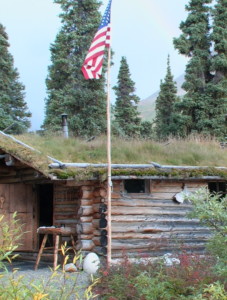
Pole structure on sod in 2005.
Monroe and Tony worked on the pole structures for Dick’s cabin. Photos of Dick’s cabin show a spruce pole structure on top of the sod. Dick knew this structure was not needed to hold down the sod; he just liked the visual effect the structure gave to his wilderness cabin.
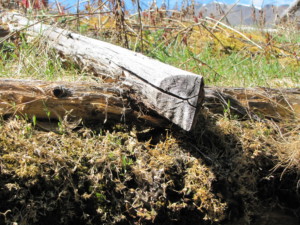
Notice the rot in 2000 in the horizontal pole.
Dick’s original pole structures were badly rotted and Monroe replaced them in 2000 keeping as much as possible to Dick’s pole sizes, connecting joints and end cuts.
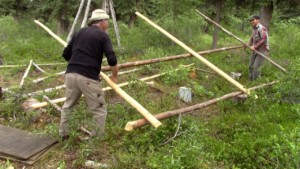
Monroe and Tony move the newly made pole structure to the back side of the cabin roof.
In 2017, they made new spruce pole structures, holding true to Dick’s craftsmanship.
.
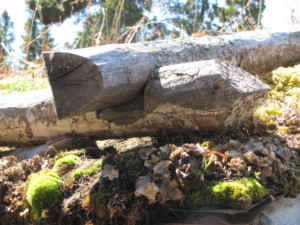
‘V’ fit joint.
Dick made most of the roof pole structure joints with the same saddle notch fit that he used on the corners of his cabin. But on a few of the pole structure joints Dick made an effective ‘V’ fit joint that could quickly be made with a handsaw. Supporting the pole structure above the sod on small pieces of firewood as seen in this photo will add longevity to the poles by keeping them dryer.

The finished cabin roof! Beautiful!!
The park pilots Don Welty and Rich Richotte worked amazing hours to get all the materials out to Twin Lakes making sure every available minute could be used for construction therefore completing the task as quickly as possible.
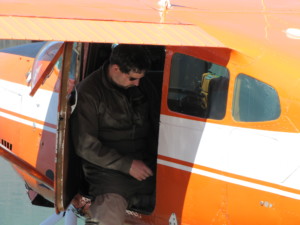
Rich Richotte (park pilot/ranger).
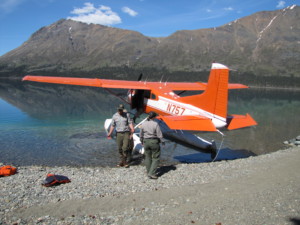
Park plane with materials for the project.
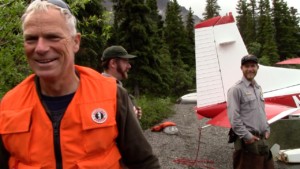
Don Welty (park pilot) brings in more materials for the project.
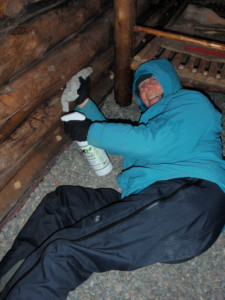
K. Schubeck scrubbing wall with mold cleaner.
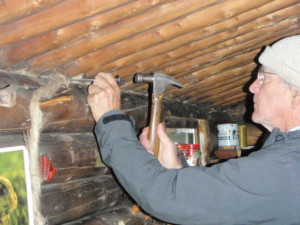
Monroe driving oakum around rafter poles.
